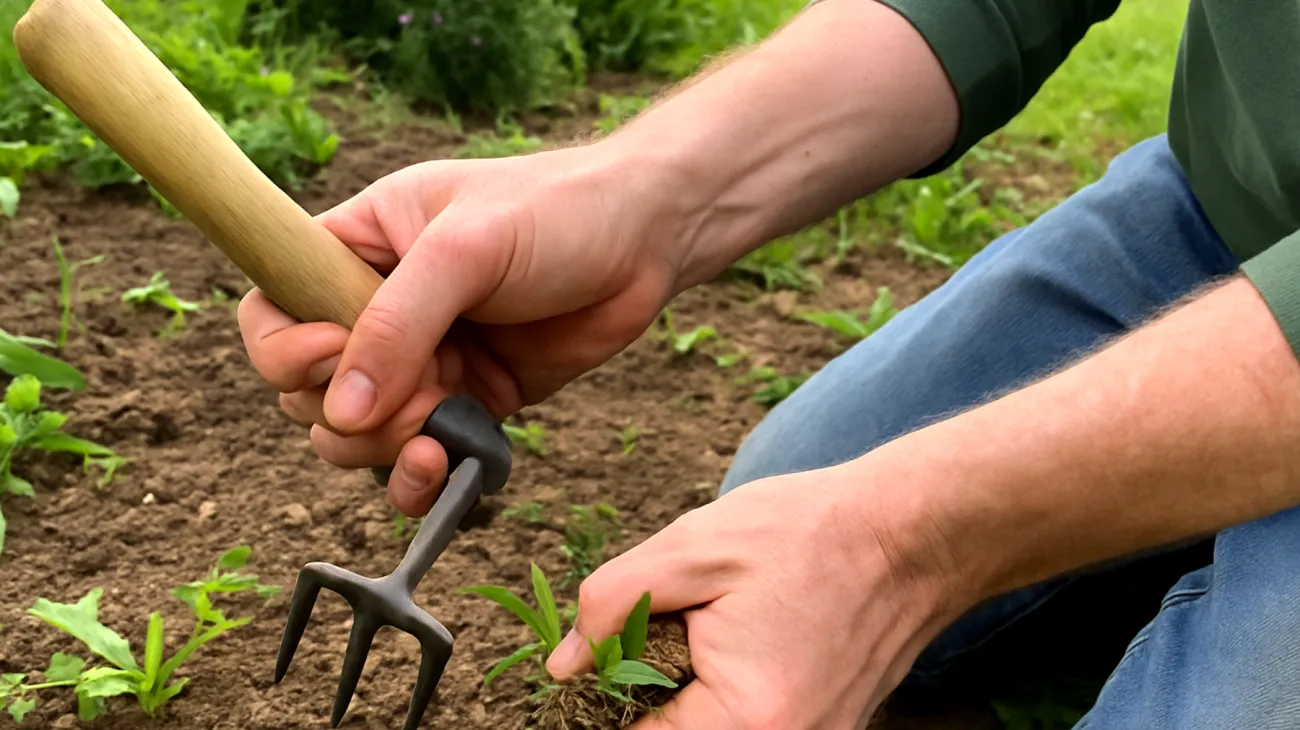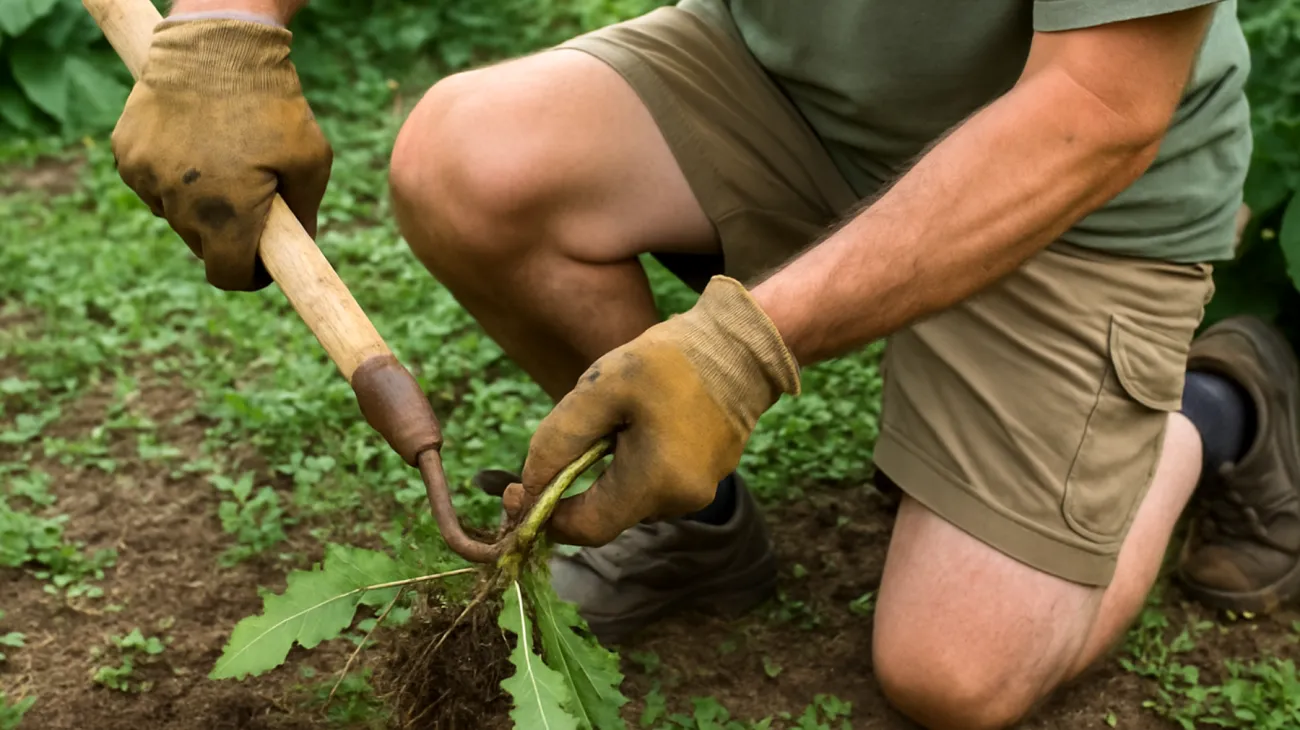Few things test a gardener’s patience like stubborn weeds buried deep in dry, compacted soil. The problem often isn’t the weed itself — it’s how the weeder is used. While it might seem like a humble hand tool without much fanfare, the humble weeder has everything to do with protecting your hands, cutting down fatigue, and ensuring that your garden beds remain productive.
Hard, dry earth? That’s a fast track to blunted blades and sore wrists. Yanking the tool straight up from the wrong angle? Say goodbye to root extraction and hello to soil disruption. Even choosing a weeder unsuited to your weed problem is a surefire way to double your hours in the garden — and halve your enthusiasm.
When wielded correctly — and in the right conditions — a weeder becomes a precision tool that reduces physical strain, prevents unnecessary tool wear, and saves considerable time. The key lies in understanding the fundamental principles that govern effective weeding, from soil mechanics to ergonomic positioning.
The Foundation of Efficient Weeding: Understanding Your Battlefield
Before diving into technique, it’s crucial to recognize that weeding is far more complex than simply removing unwanted plants. The interaction between tool, soil, plant, and user creates a dynamic system where small changes in approach can yield dramatically different results.
The most common mistake? Treating all weeding scenarios as identical. A dandelion in clay soil requires a completely different approach than chickweed in sandy loam. Understanding these distinctions is what separates efficient gardeners from those who spend hours struggling with their tools, often achieving mediocre results while wearing themselves out in the process.
Professional landscapers and experienced horticulturists have long recognized that effective weeding is as much about reading conditions as it is about applying technique. This understanding forms the foundation of every efficient weeding strategy, influencing everything from tool selection to timing and body positioning.
Why Timing and Soil Moisture Drastically Influence Weeder Performance
Gardeners often reach for the weeder whenever weeds are visible, without considering soil moisture, which dramatically affects both tool efficiency and plant extraction success. This oversight represents one of the most significant factors in weeding frustration and inefficiency.
Dry soil clings tightly to roots and resists penetration. Forcing a weeder in these conditions increases pressure on both your body and the tool’s fulcrum — especially if it’s a narrow-tipped model meant for precision. The resistance encountered in dry soil isn’t just an inconvenience; it’s a direct pathway to tool damage and physical strain that accumulates over time.
Conversely, moist soil allows the blade to slice cleanly through the earth, follow roots easily, and lift entire plants with far less resistance. This principle, while seemingly obvious, is consistently overlooked by gardeners eager to tackle visible weed problems regardless of conditions.
The benefits of working in appropriately moist soil extend beyond mere convenience. When soil moisture content is optimal, weeding becomes a fundamentally different activity. Physical effort requirements are substantially reduced, the risk of breaking weed roots decreases significantly, blade dulling from scraping dry dirt is prevented, and root extraction becomes more complete.
Set your routine accordingly: Early morning, after overnight dew or a light rain, represents ideal conditions for weeding activities. The soil has absorbed moisture without becoming waterlogged, creating the perfect balance for efficient tool penetration and root extraction.
When natural moisture isn’t available, creating optimal conditions becomes part of the weeding strategy. Pre-soaking the area you’re working with for 15–20 minutes using a targeted watering can transforms difficult weeding terrain into manageable workspace. This small investment of time and water pays dividends in reduced effort and improved results.
The Mechanics of Leverage: Working Smarter, Not Harder
Understanding how to apply proper leverage distinguishes efficient weeding from exhausting struggle. Most weeding fatigue and tool damage stems from poor leverage application, yet this critical aspect of technique receives little attention in gardening discussions.
Angle determines everything. Misaligned pressure is what causes most premature weeder damage — bent shafts, cracked joints, and dulled edges. Generating efficient torque without exhausting yourself comes down to basic physics: the application of leverage in harmony with natural body mechanics.
The optimal angle to introduce a weeder into soil hovers around 45 degrees, though this may vary slightly depending on soil type and weed species. This orientation allows the blade or claw to approach beneath the weed’s taproot, positioning the tool for maximum extraction leverage while preserving soil structure around desirable plants.
The technique itself requires patience and precision rather than force. Start insertion just beside the base of the weed — not from above — with a firm, controlled push, and then pivot gently rather than yanking. This approach encourages complete root removal over breakage, addressing the weed problem definitively rather than temporarily.
For taproot weeds like dandelions or dock, a narrow weeder such as a fishtail or dandelion fork maintains clean penetration with minimal soil disruption. The goal is surgical precision: removing the entire root system is crucial to prevent regeneration.
Think of your weeder as a scalpel, not a machete. Precision and proper technique will always outperform brute force in both efficiency and results.
Selecting the Right Weeder for the Problem You Face
A universal mistake that plagues many gardening endeavors involves treating all weeds — and all weeders — as if they’re interchangeable. The reality is that the wrong type of weeder will work against you, not with you, creating unnecessary struggle and poor results regardless of technique quality.
Different weed species, root systems, and growing conditions require different mechanical approaches. Using a tool designed for one application in an inappropriate situation not only reduces efficiency but can also damage both the tool and the garden environment.
The fishtail or dandelion weeder excels at addressing deep-rooted plants with substantial taproots. Its narrow blade design allows clean entry into soil without disturbing nearby plants, while the pointed tip can follow taproots to considerable depths. The leverage provided by the longer shaft makes extraction of established perennial weeds manageable without excessive physical effort.
Cobra-head or curved blade weeders serve different purposes entirely. These tools excel with fibrous-rooted weeds in tight spaces, using a claw-like motion for shallow but effective scraping. Their curved design mimics natural hand motion, reducing wrist strain during extended use while providing excellent control in confined areas.

Loop or stirrup hoes represent another category altogether, designed specifically for slicing off annual weed seedlings just under the surface. These tools work best with a sweeping motion rather than stabbing, cutting through small weeds efficiently while leaving soil structure largely undisturbed.
Matching Tool to Battlefield
The key principle remains consistent: match the tool to its battlefield. Attempting to pry out a deep dandelion with a stirrup hoe not only wastes energy but also shears the root, ensuring the weed returns within days. Similarly, using a long-handled tool for precision work around delicate seedlings often results in collateral damage to desirable plants.
For gardeners dealing with mixed weed populations — taproots, rhizomes, and creeping stems in the same area — a multi-pronged weeder with interchangeable tips offers versatility and minimizes the need to switch tools constantly. While these tools may represent a higher initial investment, they often prove more efficient and cost-effective for diverse weeding challenges.
The Hidden Costs of Tool Misuse
Most gardeners don’t realize that their weeding tools aren’t failing due to manufacturing defects or normal wear — they’re being inadvertently destroyed through misuse. Understanding how tool damage occurs reveals pathways to both longer tool life and more efficient weeding practices.
Tool replacement represents a hidden cost in many gardening operations. Most weeders aren’t replaced because they rust — they’re replaced because they’ve been bent, blunted, or wrenched beyond repair, usually during forceful use in inappropriate conditions. A steel shaft can only tolerate limited lateral torque before it deforms permanently.
- Using the weeder as a shovel in compacted soil stresses welded joints beyond their design parameters
- Applying twisting motion to a stuck tool leads to shaft warping that makes precision work impossible
- Failing to clean or dry the blade accelerates rust formation and weakens structural integrity
- Attempting to pry out large weeds with small tools creates mechanical fatigue that accumulates over time
Protecting your tool investment requires implementing basic maintenance habits. Rinsing and drying the blade after each use prevents corrosive buildup that weakens metal components. Monthly sharpening of the tip with a flat metal file maintains cutting efficiency and reduces the force required for soil penetration.
Periodic maintenance extends to lubrication and protection. Occasionally oiling metal parts with linseed oil prevents corrosion while lubricating joint movement for smoother operation. This simple step can extend tool life significantly while maintaining peak performance characteristics.
The Overlooked Value of Ergonomic Positioning
Weeding, when performed incorrectly, becomes a repetitive strain exercise that can lead to significant physical discomfort and potential injury. One of the most startling oversights in garden ergonomics involves posture and body mechanics during weeding activities.
The standard weeding technique taught in many gardening resources — squatting or kneeling directly over the weed — generates prolonged pressure on wrists, lower back, and knee joints. This positioning not only increases fatigue but can also contribute to repetitive stress injuries that develop gradually over time.
Professional landscapers and occupational health specialists have identified key principles that transform weeding from a physically punishing activity into sustainable garden maintenance. These principles focus on maintaining natural body alignment while optimizing leverage and control.
Wrist positioning represents perhaps the most critical factor in preventing repetitive stress injuries. Keeping your wrist in a neutral, straight position while gripping the tool maintains natural joint alignment and prevents the hyperextension that leads to strain. Bracing your forearm gently against your thigh provides additional control while reducing hand tremor and muscle fatigue.
Recognizing When to Stop
Experienced gardeners understand that personal energy represents a finite resource that must be managed strategically. However, many gardeners fail to account for this reality, pushing through fatigue in ways that reduce efficiency and increase risk.
The temptation to ‘just finish the corner’ or ‘get the last patch before dusk’ often leads to the least efficient portion of any weeding session. Inefficient weeding typically begins in the final 30 minutes of extended sessions, when attention drops and shortcuts begin to seem attractive.
Key indicators include unconsciously applying more body weight to the tool, experiencing frequent root breakage rather than complete extraction, and noticing a disproportionate rise in effort-to-result ratio. These warning signs indicate that continuing weeding activities will likely produce poor results while increasing the risk of tool damage and personal injury.
Short, efficient weeding sessions consistently outperform marathon efforts in both results achieved and physical cost. This understanding allows gardeners to plan weeding activities as part of a sustainable garden maintenance routine rather than exhausting ordeals to be endured.
A Smarter Way to Weed
The transformation from inefficient struggle to effective garden maintenance doesn’t require expensive equipment or radical changes in approach. It does require understanding the principles that govern efficient weeding and applying them consistently.
When performed using proper technique — in appropriate soil moisture conditions, with correctly matched tools, at optimal angles, and with sound ergonomic practices — weeding becomes an almost effortless part of garden routine. Your tools last longer, your body remains comfortable, and your garden thrives with less soil compaction and root damage.
The shift in perspective from dreading weeding to viewing it as a resource-efficient practice transforms the entire gardening experience. The compound benefits of proper technique accumulate over time, creating gardening practices that remain sustainable and enjoyable for years to come.
Sometimes, the path to a better garden doesn’t lie in purchasing more tools or implementing complex systems. Often, the most significant improvements come from using existing tools in the way they were designed to be used: thoughtfully, effectively, and in harmony with both soil conditions and human biomechanics. Through consistent application of these principles, gardeners can develop practices that serve them well throughout their gardening journey, creating beautiful, productive spaces while maintaining their own health and well-being.
Table of Contents

